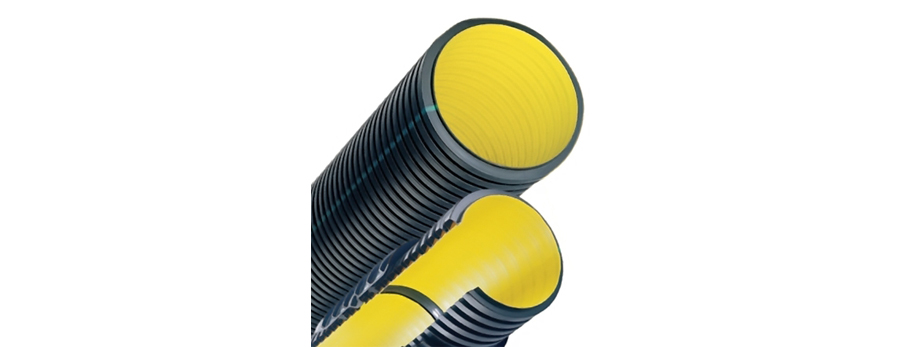KORUGE PIPE GENERAL FEATURES
Sewer pipes are a product produced from Polypropylene and Polyethylene raw materials in the Polyolefin group. Extruded décor pipes produced up to Ø450 mm diameter can be produced from polyethylene and polypropylene raw materials, while spiral corrugated pipes are produced from polyethylene. The ring strength value of the same thickness is higher in polypropylene, so it is more preferred. With the spiral method, pipes with a diameter of Ø500 mm and above are produced. Dizayn Group has the technology of producing corrugated spiral pipes up to 8.000 mm diameter.
While extruded décor pipes are combined with fittings, spiral corrugated pipes have bellmouth and spigot (male) ends, no fitting is needed in straight pipe joining.
Coiled corrugated pipes can be joined by extruder welding, gasketed method as well as electrofusion method. This joining method makes the pipes normally used under 0.5 bar pressure usable even at 4 bar. In this way, the pipes continue to work without leaking and without damaging the joints in the pressure increase encountered in the rain that turns into flood.
Corrugated pipes are sold with a 50-year life guarantee because they are not affected by corrosion and have high abrasion and chemical resistance. Thanks to their flexible structure, they perform their activities without being affected by earthquakes such as earthquakes. Since the impermeability is provided throughout the life of the pipe, underground water and Contamination of the soil is prevented. There is no question of the tree roots entering into the pipe and closing.
PRODUCTION FEATURES
Corrugated pipes have two different production methods. They are produced in a continuous, single process extruder and spiral method on a mandrel. The production capacity of extruded décor pipes is very high and the ring strength value is stable since the product shape cannot be changed. Spiral corrugated pipes can be produced at the desired ring strength value, at optimum weight, depending on the project.
Pipes consist of two layers, the inner pipe layer and the outer rib layer. The inner layer is a straight pipe that carries the fluid. The outer layer is ribbed. Both layers are molecularly linked to each other. Since the hollow rib structure on the outside can carry loads close to the full structure, it is preferred for saving raw material and reducing the weight of the pipe.
Extruded décor pipes come out of the extruder in two layers and the outer layer is shaped by molds. In the spiral corrugated pipe, first the inner pipe is turned into a pipe by wrapping the polyethylene in the form of a strip one on top of the other in the mandrel. Subsequently, the profile drawn product is wrapped on the pipe and welded. Both products show monolithic features with their welded structure.
ADVANTAGES
- Polyethylene and Polypropylene, showing high resistance to corrosion.
- It has a guaranteed life of at least 50 years against external effects and can be used for 100 years.
- Since the plastics are hydraulic smooth, they show little resistance to the fluid and the fluid flows with a higher filling rate. This pulls down the project costs by selecting a lower diameter group in the project.
- There is no product loss during application.
- Since its density is very low compared to concrete and pouring, the need for a construction machine decreases to minimum levels.
- Due to its high abrasion resistance, it does not allow contamination of groundwater and soil by drilling.
- Even if the ground is gravel, it prevents breaking by stretching inwards from that area under excessive load.
- It does not allow the trees to seep into the channel and block it.
- All kinds of fittings allow the special product to be produced for the project.
- When combined with electrofusion, it is impermeable even at 4 bar pressure, it does not disintegrate.
- It does not fail by breaking due to the shakes in the earthquake.
- It can be used in river, lake and sea crossings.
- It can be used to discharge the pre-treated water taken from treatment plants up to sea currents.
THINGS TO PAY ATTENTION
While filling the channel, compression should be made layer by layer to avoid any gaps around the pipes. In particular, it should be ensured that the bottom of the pipe is filled with filling material. If the filling is done by compacting according to the specification, the traffic and soil load coming to the pipe are transferred to the filling, and the pipe will fulfill its duty throughout its life. Otherwise, the pipe carries what it can carry when there is a gap, and collapses when it cannot find a place to transfer it with the forces above it. The same is true for steel pipes. In sealed systems, lubricants such as soap and silicone should be used in order for the pipes to enter the fitting. Before electrofusion welding, it should be checked that the surfaces are clean. It should be noted that the wires do not touch each other before welding. Service Life 50 years life under 0.5 bar pressure. Since it is produced by adding carbon black, it is not affected by ultraviolet rays from the sun.
FREQUENTLY ASKED QUESTIONS
1. What is its raw material?
It is made of Polyethylene (PE) and Polypropylene (PP) raw materials. PP gives more SR (Ring Strength) value at the same wall thickness.
2. Why is it ribbed?
When a load is placed on an object with a certain thickness, the outer layer carries the most load. In the center, this value is zero. Savings are made on the material of the part carrying less load. The pipe weight is also significantly reduced.
3. How many layers does the pipe have?
Those produced in one piece consist of two layers. Rib form is given to the outer layer. Spirals can be manufactured in different profiles and multi-layered according to the project.
4. What are the joining methods?
Corrugated pipes are combined with a gasket method up to a diameter of 450 mm. Spiral pipes in upper diameters are combined with extrusion welding and electrofusion welds that enable them to be used up to 4 bar pressure.







